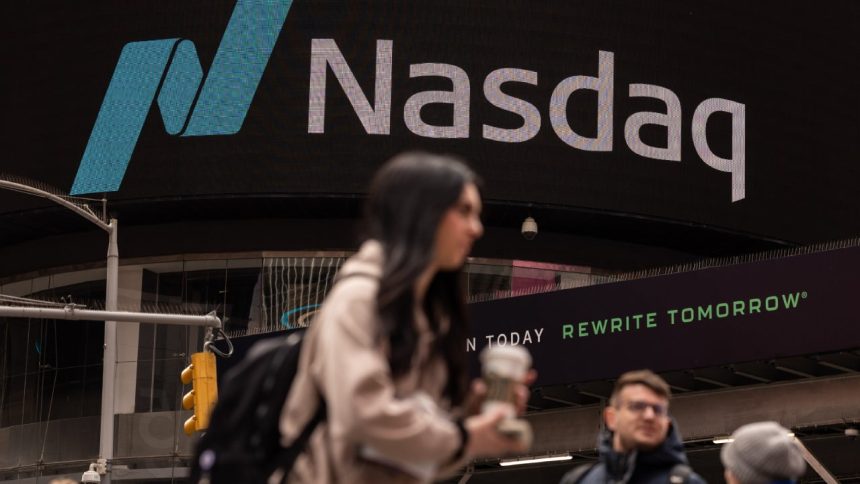The Nasdaq 100 Index is one of the most popular stock indexes and includes the 100 largest non-financial companies trading on the Nasdaq stock exchange. The Nasdaq 100 numbers huge tech stocks such as Apple, Microsoft, Amazon, Alphabet and the other Magnificent 7 stocks. But don’t confuse this index with the Nasdaq Composite, which contains thousands of stocks.
Here’s how the Nasdaq 100 works, which companies are in it and how they get added.
What is the Nasdaq 100?
The Nasdaq 100 Index is a collection of the 100 largest non-financial companies trading on the Nasdaq stock exchange. The index is weighted according to each stock’s market capitalization – the total value of all its outstanding shares – so that larger companies carry a heavier weighting.
The index features the world’s largest companies, including multi-trillion-dollar tech stocks that dominate the news. These stocks include the mega-caps as well as many large-cap stocks. To be part of the index requires meeting special criteria, which are detailed below.
For a company, it’s valuable to be included in the index. When a firm joins the index, investment funds tracking the index must add the stock to their portfolios. They’ll need to purchase the stock, tending to push up its price, while they sell the stock leaving the index. And as more money is added to Nasdaq 100 index funds, the fund company must buy all the stocks in it.
This inflow of money keeps upward pressure on stocks in the Nasdaq 100. And a strong stock makes it cheaper for companies to raise money by issuing new shares of stock and make the firm more attractive. So, being added to the index is prestigious as well as financially valuable.
The price of the index that you may see quoted is measured in points, not dollars. That figure is the weighted average value of all components of the index. As the individual stocks move higher and lower, the index rises and falls depending on the exact calculation of the index.
The Nasdaq 100 is similar to other major stock indexes such as the Dow Jones Industrial Average, which tracks 30 stocks across various industries, and the Standard & Poor’s 500 Index, which tracks hundreds of companies across all industries.
Finally, it’s important to note the distinction between the Nasdaq 100 and the Nasdaq Composite, which tracks more than 3,000 stocks trading on the Nasdaq exchange, not just the largest, as on the Nasdaq 100.
10 largest companies in the Nasdaq 100
Below are the ten largest companies in the Nasdaq 100 and their total weighting in the index, as of May 1, 2024.
- Microsoft (MSFT) – 8.59 percent
- Apple (AAPL) – 7.70 percent
- Nvidia (NVDA) – 6.31 percent
- Amazon (AMZN) – 5.40 percent
- Broadcom (AVGO) – 4.61 percent
- Meta Platforms (META) – 4.35 percent
- Alphabet Class A (GOOGL) – 2.81 percent
- Alphabet Class C (GOOG) – 2.74 percent
- Tesla (TSLA) – 2.69 percent
- Costco Wholesale (COST) – 2.39 percent
Altogether, the 10 largest stocks in the Nasdaq 100 make up more than 47 percent of the total index, which is a huge concentration. So these big bellwether stocks have a huge impact on the index.
As for why there are two entries for Alphabet on the list, that’s because the parent of Google has multiple share classes, so each share class is listed separately based on its weighting.
How stocks get added to the Nasdaq 100
Nasdaq has specific criteria for which companies are added to the 100 index, which is done once annually, in December.
- The stock must be traded on the Nasdaq Global Select Market or the Nasdaq Global Market.
- Both American and foreign stocks are eligible for inclusion, but foreign companies must have options listed on a registered options market in the U.S. or be eligible to do so.
- The stock must be a non-financial company and must not be a real estate investment trust (REIT).
- The stock may be of any market capitalization, though only the largest 100 stocks are included in the index.
- The stock must trade at least 200,000 shares on average per day.
- The stock must have traded publicly for at least three months, including Nasdaq and New York Stock Exchange markets.
Those are the most important considerations for inclusion in the index, though a few others exist.
The Nasdaq 100 has delivered excellent returns
The returns on the Nasdaq 100 have been almost unbelievable. The index has outpaced the S&P 500, which itself has delivered about 10 percent annually over long periods. The strong weighting in the highest performers has powered the Nasdaq 100 ahead, though.
Here are the index’s annualized returns and total returns to May 1, 2024.
| Time | 1 year | 3 years | 5 years | 10 years |
|---|---|---|---|---|
| Annualized return | 30.9% | 7.7% | 17.4% | 17.0% |
| Total return | 30.9% | 24.9% | 123.4% | 381.8% |
Source: Yahoo Finance
This kind of performance is why many smart investors decide to simply buy and hold their investments rather than trying to jump in and out of the market. By being an active investor, you’re more likely to miss a big move in the index, leading to serious underperformance over time.
How to invest in the Nasdaq 100 index
Investors looking to enjoy the returns of the Nasdaq 100 have a few options, whether that’s through one of the best mutual funds or the best ETFs. Investors can purchase a Nasdaq 100 index fund and enjoy returns that closely mirror the index or even juice those numbers with a leveraged fund.
- Invesco QQQ Trust ETF (QQQ): This fund lands on our list of best index funds, and it tracks the Nasdaq 100 index, meaning your gains will be about what the index delivers. The expense ratio is a reasonable 0.20 percent.
- Invesco Nasdaq 100 ETF (QQQM): This fund tracks the index just like its larger cousin but delivers the performance at a low expense ratio of just 0.15 percent.
- ProShares UltraPro QQQ (TQQQ): This leveraged ETF tries to get three times the daily return of the Nasdaq 100 using the power of leverage. The longer-term returns have been excellent, but it’s been a roller coaster ride. The fund’s expense ratio is 0.88 percent.
- Shelton Nasdaq 100 Index Direct (NASDX): This mutual fund tracks the regular Nasdaq 100, and charges a heftier expense ratio of 0.52 percent.
- Direxion Nasdaq 100 Equal Weighted Index Shares ETF (QQQE): This fund weights the stocks in the Nasdaq 100 equally, rather than assigning the top-heavy weighting of the regular index. Returns have still been strong, while the expense ratio is 0.35 percent.
The upshot for investors is that they have plenty of affordable ways to enjoy the Nasdaq 100’s outperformance, whether through ETFs or mutual funds. If you want an even more diversified portfolio, then turn to an S&P 500 index fund, which still owns sizable pieces of top tech stocks.
Bottom line
The Nasdaq 100 is one of the most popular stock indexes because of its strong exposure to the world’s hottest tech stocks. Like the stocks comprising it, the Nasdaq 100 seems to keep growing year after year, delivering solid returns to investors over long periods of time.
Editorial Disclaimer: All investors are advised to conduct their own independent research into investment strategies before making an investment decision. In addition, investors are advised that past investment product performance is no guarantee of future price appreciation.
Read the full article here














